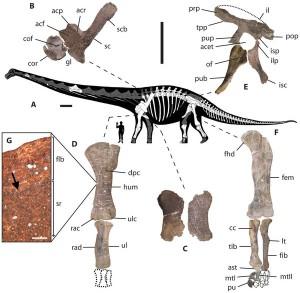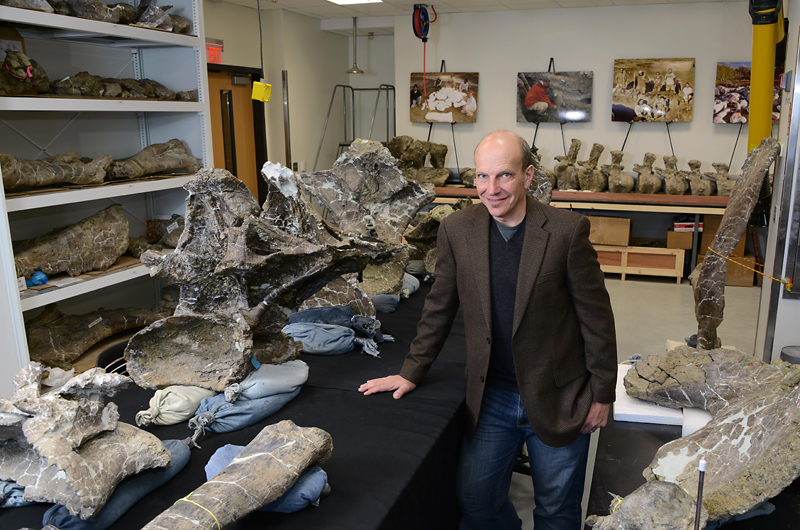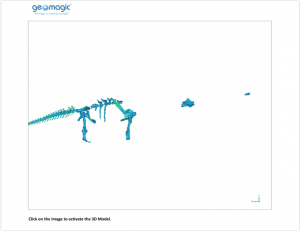Q: How do you study a 130,000-pound dinosaur?
A: Any way it wants you to.
We have seen numerous ways in which 3D technology has assisted in the research, documentation, and dissemination of information about dinosaurs. High school children have used 3D printers to replicate the bones of dinosaurs in order to study both the bones and the technology, and there is no shortage of other venues realizing the possibilities for 3D printed dinosaur memorabilia and study aides.
This time, even those who are nonplussed by the size of the magnificent brontosaurus or terrifying tyrannosaurus Rex have to admit that this latest project at the Carnegie Museum of Natural History is moving 3D to a truly monumental scale. A team of researchers have recently completed laser scans of the bones of a dinosaur known as the “dreadnoughtus.” The specimen of dreadnoughtus at Carnegie was merely an adolescent when it surrendered its 85 foot long, 30 foot tall, 130,000 pound body to the earth.
 Its skeletal remains were uncovered in Patagonia and represent the single most complete set of remains to have ever been discovered. To put its size in perspective, realize that a Boeing 737 only weighs about 93,700 pounds. This creature makes the world’s largest currently living land mammal, the male African elephant weighing in at the diminutive 15,000 pounds, seem as a Chihuahua to a Great Dane. What is even more mind-boggling, is that the dreadnoughtus is possibly still not the biggest of the dinosaurs. It is, in fact, a member of a group of dinosaurs collectively referred to as titanosaurs.
Its skeletal remains were uncovered in Patagonia and represent the single most complete set of remains to have ever been discovered. To put its size in perspective, realize that a Boeing 737 only weighs about 93,700 pounds. This creature makes the world’s largest currently living land mammal, the male African elephant weighing in at the diminutive 15,000 pounds, seem as a Chihuahua to a Great Dane. What is even more mind-boggling, is that the dreadnoughtus is possibly still not the biggest of the dinosaurs. It is, in fact, a member of a group of dinosaurs collectively referred to as titanosaurs.
Having carefully excavated over 200 bones, the researchers possess only slightly less than 50% of the complete skeleton. The left thighbone by itself is over 6 feet tall. The logistics of unearthing this beast were trumped only by those required for transporting and housing the creature. Assembling the vertebrae of the dinosaur’s tail required 30 feet of space and in its current location turns at least one corner. Its other bones, including a neck vertebra with a 3-foot diameter, filled most of the office of its discoverer Dr. Kenneth Lacovara.
 Dr. Locovara and his team decided early on that it would be important to create 3D scans of the bones. This is in line with a larger trend in paleontological and archaeological documentation. In this case however, it makes particularly good sense given the immense proportions of the bones and the equally enormous cost of transporting them. They are singularly location bound, and prior to the availability of 3D scanning there would have been no reasonable way to study them other than by being in Dr. Locovara’s office.
Dr. Locovara and his team decided early on that it would be important to create 3D scans of the bones. This is in line with a larger trend in paleontological and archaeological documentation. In this case however, it makes particularly good sense given the immense proportions of the bones and the equally enormous cost of transporting them. They are singularly location bound, and prior to the availability of 3D scanning there would have been no reasonable way to study them other than by being in Dr. Locovara’s office.
 As a way of making the skeletal remains available for study by a much wider audience, 3D images of the bones have also been made available for free download. The scans themselves were made using a NextEngine Model 2020i Desktop 3D Laser Scanner. Digital models of those scanned elements were then created with NextEngine ScanStudio HD PRO software and further manipulated using Autodesk’s Maya 3D animation program. The images were then exported into a series of 3D PDF files using Geomagic Studio software and can be viewed and manipulated by anyone with access to the Adobe reader. The files contain different components of the enormous skeleton with the added benefit that each bone is on a separate layer that can be individually examined.
As a way of making the skeletal remains available for study by a much wider audience, 3D images of the bones have also been made available for free download. The scans themselves were made using a NextEngine Model 2020i Desktop 3D Laser Scanner. Digital models of those scanned elements were then created with NextEngine ScanStudio HD PRO software and further manipulated using Autodesk’s Maya 3D animation program. The images were then exported into a series of 3D PDF files using Geomagic Studio software and can be viewed and manipulated by anyone with access to the Adobe reader. The files contain different components of the enormous skeleton with the added benefit that each bone is on a separate layer that can be individually examined.
In addition to the “cool factor” of having a 3D image of a dinosaur, there is much to be gained by using these scans to study the morphology of such gargantuan creatures. Dr. Lacovara and his team of researchers discussed the benefits of utilizing this process with their dreadnoughtus skeleton:
“Assembling the actual bones into a physical mounted skeleton would be physically, technically, and financially challenging, and risk damage to the fossils. Compounding these liabilities, mounted specimens can be difficult to disarticulate for further examination, which can deter future study. In a virtual environment, fossil bones weighing hundreds of kilograms can be manipulated with ease, thus facilitating the testing of anatomical and biomechanical hypotheses.”
 The digital models that they created have also been useful for 3D printing small scale replicas of the bones to act as scaffolding for hypotheses regarding musculature and other soft tissue questions. As there is evidence to suggest that there are even bigger dinosaurs that may one day be uncovered, the use of these types of technologies on the dreadnoughtus provides a useful model, whatever the size of the next great find. Let’s hear your thoughts on what 3D scanning is allowing researchers to accomplish in the 3D scanned dreadnoughtus forum thread on 3DPB.com. For those of you interested, the 3D files of this massive creature are available for free download here.
The digital models that they created have also been useful for 3D printing small scale replicas of the bones to act as scaffolding for hypotheses regarding musculature and other soft tissue questions. As there is evidence to suggest that there are even bigger dinosaurs that may one day be uncovered, the use of these types of technologies on the dreadnoughtus provides a useful model, whatever the size of the next great find. Let’s hear your thoughts on what 3D scanning is allowing researchers to accomplish in the 3D scanned dreadnoughtus forum thread on 3DPB.com. For those of you interested, the 3D files of this massive creature are available for free download here.
Subscribe to Our Email Newsletter
Stay up-to-date on all the latest news from the 3D printing industry and receive information and offers from third party vendors.
You May Also Like
Precision at the Microscale: UK Researchers Advance Medical Devices with BMF’s 3D Printing Tech
University of Nottingham researchers are using Boston Micro Fabrication‘s (BMF) 3D printing technology to develop medical devices that improve compatibility with human tissue. Funded by a UK grant, this project...
3D Printing Webinar and Event Roundup: April 21, 2024
It’s another busy week of webinars and events, starting with Hannover Messe in Germany and continuing with Metalcasting Congress, Chinaplas, TechBlick’s Innovation Festival, and more. Stratasys continues its advanced training...
3D Printing Webinar and Event Roundup: March 17, 2024
It’s another busy week of webinars and events, including SALMED 2024 and AM Forum in Berlin. Stratasys continues its in-person training and is offering two webinars, ASTM is holding a...
3D Printed Micro Antenna is 15% Smaller and 6X Lighter
Horizon Microtechnologies has achieved success in creating a high-frequency D-Band horn antenna through micro 3D printing. However, this achievement did not rely solely on 3D printing; it involved a combination...





























